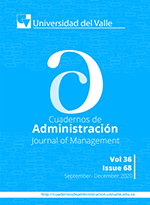Work absence, remuneration, and equity: a confused relationship
Keywords:
Human resource, Human capital, Compensation, Absenteeism, EquityMain Article Content
There are a variety of factors that directly or indirectly influence how the worker performs within the organization, such as remuneration policies, workload, job satisfaction or others. To delve into this topic, the objective of this research is to analyze the relationship between absenteeism, compensation and equity of workers through negative binomial regression. The study was carried out in a higher education institution, compiling 840 data on compensation, absenteeism and staffing, which were analyzed with respect to the corresponding year (2015-2017), month, gender and plant. A model was generated where the dependent variable is Absenteeism (days) and the independent variables are Average Income and Equity, indicating that the average income (expressed as logarithms) is an optimal predictor to determine the level of absenteeism within the organization, while the Gini Index does not generate consistent results to determine an incidence on the level of absenteeism of workers, in addition to not being influenced by either gender or plant. According to the results obtained, women have a higher level of absenteeism than men, which is why it is suggested as a future line of research to compare the levels of absenteeism between women with children and women without children. In summary, for this sample the average income (expressed as logarithms) is an adequate predictor for the level of absenteeism, while Equity is not.
Agresti, A. (2002). Categorical Data Analysis (2a ed.). New York, USA: John. Wiley & Sons.
Barroso, F. (2012, octubre). Calidad de vida laboral vs. rotación, ausentismo y productividad. Un estudio en 103 empresas de la ciudad de Mérida, Yucatán. XVII Congreso Internacionl de Contaduría, Administración e Informática.ANFECA, UNAM, Ciuda de México, México.
Cameron A. C., & Trivedi, P. K. (2013). Regression Analysis of Count Data (2nd ed.). Econometric Society Monograph, 53. Retrieved from http://cameron.econ.ucdavis.edu/racd/count.html
Carosio, A. (2010). El trabajo de las mujeres: desigualdad, invisibilidad y explotación. Revista Venezolana de Estudios de la Mujer, 15(35), 7-13.
Chiavenato, I. (2000). Administración de Recursos Humanos. Bogotá, Colombia: Editorial Mc Graw-Hill.
Chiavenato, I. (2011). Administración de recursos humanos. McGraw Hill. Recuperado de https://cucjonline.com/biblioteca/files/original/aec4d0f8da9f45c14d9687966f292cd2.pdf
Cohen, G. (1989). On the currency of egalitarian justice”. Ethics, 99(4), 906-944. Retrieved from http://www.jstor.org/stable/2381239
Dolan, S. L., Shuler, R. S., Randall, S., & Valle, R. (1999). La gestión de los Recursos Humanos. Madrid, España: Mc Graw-Hill, Interamericana de España.
Fernández, I., y Baeza, R. (2000). El Psicólogo organizacional como gestor de compensaciones. Revista tendencia en psicología contemporánea, serie azul (1), Recuperado de https://es.slideshare.net/ignacioinspirado/2002-uai-psicologo-org-como-gestor-de-compensac
García, V., y Martínez, R. (2016). Ausentismo Laboral y Salud: Estudio de su importancia en el teletrabajo. Retos, 6(11). doi: 10.17163/ret.n11.2016.01
Hoffmeister, L., Vidal, C., Vallebuona, C., Ferrer, N., Vásquez, P., y Nuñez, G. (2014). Factores asociados a accidentes, enfermedades y ausentismo laboral: Análisis de una cohorte de trabajadores formales en Chile. Retrieved from https://scielo.conicyt.cl/scielo.php?script=sci_arttext&pid=S0718-24492014000100005
Jarque, Carlos M., & Bera, A. K. (1987). A test for normality of observations and regression residuals. International Statistical Review 55(2), 163-172. https://doi.org/10.2307/1403192
Kruskal, W., & Wallis, W. (1952). Use of Ranks in One-Criterion Variance Analysis. Journal of the American Statistical Association, 47, 583-621. https://psycnet.apa.org/doi/10.2307/2280779
Lawler, E. (1990). Strategic Pay: Aligning Organizational Strategies and Pay Systems. San Francisco, USA: Jossey-Bass Inc., Publishers.
Lilliefors, H. W. (1967). On the Kolmogorov-Smirnov test for normality with mean and variance unknown. Journal of the American Statistical Association, 62, 399-402. http://dx.doi.org/10.1080/01621459.1967.10482916
Lorenz, M. O. (1905). Methods of Measuring the Concentration of Wealth. Publications of the American Statistical Association, 9(70), 209-219, Retrieved from https://www.tandfonline.com/doi/abs/10.1080/15225437.1905.10503443
Mann, H. B., & Whitney, D. R. (1947). On a test of whether one of two random variables is stochastically larger than the other. Annals of Mathematical Statistics, 18, 50-60. https://doi.org/10.1214/aoms/1177730491
Méndez-Ramírez, O. (2013). Neoliberalismo y equidad: la sociedad chilena analizada desde una perspectiva estudiantil. Revista Iberoamericana de Educación Superior, 11. https://doi.org/10.22201/iisue.20072872e.2013.11
Mendoza, R. (2015). Insatisfacción laboral como predictor del ausentismo en un hospital público. Revista médica de Chile, 143(8), 1028-1033. https://dx.doi.org/10.4067/S0034-98872015000800010
Milkovich, G., & Newman, J. (1996). Compensation, USA: Editorial Irwin, McGraw-Hill. Retrieved from https://www.tandfonline.com/doi/abs/10.1080/0958519032000145792
Ministerio de Hacienda. (2005). Fija texto refundido, coordinado y sistematizado de la ley Nº 18.834 sobre Estatuto Administrativo del Estado de Chile (D.F.L. N° 29, ). Recuperado de https://www.bcn.cl/leychile/navegar?idNorma=236392
Morgan, W. (1983). Administración de personal. México: Editorial Limusa.
Müller M. (2000) Generalized Linear Models. XploRe — Learning Guide, 205-228. https://doi.org/10.1007/978-3-642-60232-0_7
Nagelkerke, N. (1991). A Note on a General Definition of the Coefficient of Determination. Biometrika, 78(3), 691-692. Retrieved from https://www.jstor.org/stable/i315532
Nazario, R. (2006). Beneficios y Motivación de los empleados. INVENIO 9(17), 133-145. Recuperado de https://www.redalyc.org/pdf/877/87791710.pdf
Organización Internacional del Trabajo (1991). Enciclopedia de Salud, Seguridad e Higiene en el Trabajo (pp. 5-11, Tom. 1). Madrid, España: Centro de Publicaciones del Ministerio del Trabajo y Seguridad Social. Recuperado de https://www.insst.es/documents/94886/161958/Sumario+del+Volumen+I/18ea3013-6f64-4997-88a1-0aadd719faac
Project Management Institute. (2013). Guía de los fundamentos para la dirección de proyectos (PMBOK guide) (5a ed.). Pennsylvania, USA: Project Management Institute.
Purcell, N. (2011). Cabezas que gano, colas que suelta: necesita reformar la compensación ejecutiva. Revista de ética empresarial internacional, 4(1), 3–9.
Robbins, S. (2005). Administración (8a ed.). Naucalpan de Juárez, México: Editorial Pearson,
Sánchez, A., Rivera, E., y Velasco, J., (2016). Desigualdades de género en ciencia, el caso de las científicas de la UAEMéx. Cuadernos Intercambio sobre Centroamérica y el Caribe, 13(2), 85-112. Recuperado de https://dialnet.unirioja.es/descarga/articulo/5695896.pdf
Venables W. N., & Ripley, B. D. (2002). Modern Applied Statistics with S. (Fourth ed.). New York, USA: Springer. Retrieved from http://www.stats.ox.ac.uk/pub/MASS4
Wayne, R., y Noe, R. (2005). Administración de Recursos Humanos. México: Prentice Hall. Recuperado de https://cucjonline.com/biblioteca/files/original/ccc71a187c22e0bac95c3267e2888f6f.pdf
Worldatwork. (2016). En línea. Recuperado de http://www.worldatwork.org

This work is licensed under a Creative Commons Attribution-NonCommercial-NoDerivatives 4.0 International License.

